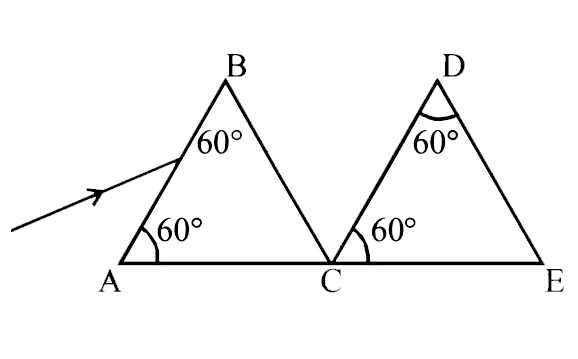Are the incident of emergent rays symmetrical with respect to the base of a prism in minimum deviation position ?
Yes
Topper's Solved these Questions
- RAY OPTICS AND OPTICAL INSTRUMENTSBOOK - AAKASH INSTITUTECHAPTER - RAY OPTICS AND OPTICAL INSTRUMENTSEXERCISE - Assignment (Section - A) Objective Type Questions (One option is correct)
38 Videos
- RAY OPTICS AND OPTICAL INSTRUMENTSBOOK - AAKASH INSTITUTECHAPTER - RAY OPTICS AND OPTICAL INSTRUMENTSEXERCISE - Assignment (Section - B) Objective Type Questions (One option is correct)
16 Videos
- PHYSICAL WORLDBOOK - AAKASH INSTITUTECHAPTER - PHYSICAL WORLDEXERCISE - ASSIGNMENT (Section-B)
5 Videos
- SEMICONDUCTOR ELECTRONICS (MATERIAL, DEVICES AND SIMPLE CIRUITS )BOOK - AAKASH INSTITUTECHAPTER - SEMICONDUCTOR ELECTRONICS (MATERIAL, DEVICES AND SIMPLE CIRUITS )EXERCISE - Assignment SECTION - D (Assertion & reason type Question)
10 Videos
Similar Questions
Two identical prism of index √3 are kept as shown in the figure. A light ray strikes the first prism at face AB. Find,
(a) the angle of incidence, so that the emergent ray from the first prism has minimum deviation.
(b) through what angle the prism DCE should be rotated about C so that the final emergent ray also has minimum deviation.

View SolutionThe angle of deviation through a prism is minimum when

(A) Incident ray and emergent ray are symmetric to the prism
(B) The refracted ray inside the prism becomes parallel to its base
(C) Angle of incidence is equal to that of the angle of emergence
(D) When angle of emergence is double the angle of incidence
Choose the correct answer from the options given below :
View Solution
Knowledge Check
A ray of light is incident at an angle of 60∘ on the face of a prism with an angle of 60∘. Then the refractive index of the material of the prism is (the prism is in minimum deviation position)
A1.414B1.623C1.524D1.732Rays of light pass through an equilateral prism such that the angle of incidence is equal to the angle of emergence and the latter is equal three-fourths the angle of the prism. The angle of deviation is
A45∘B39∘C20∘D30∘Assertion : If the angles of the base of the prism are equal, then in the position of minimum deviation, the refracted ray will pass parallel to the base of prism.
Reason : In the case of minimum deviation, the angle of incidence is equal to the angle of emergence.AIf both assertion and reason are true and reason is the correct explanation of assertion.BIf both assertion and reason are true but reason is not the correct explanation of assertion.CIf assertion is true but reason is false.DIf assertion and reason both are false.
Assertion : If the angles of the base of the prism are equal, then in the position of minimum deviation, the refracted ray will pass parallel to the base of prism.
Reason : In the case of minimum deviation, the angle of incidence is equal to the angle of emergence.
View SolutionIf a light ray incidents normally on one of the faces of the prism of refractive index 2 and the emergent ray just grazes the second face of the prism, then the angle of deviation is
View SolutionA ray of light is incident at an angle of 50∘ on one face of an equilateral prism . What is the angle ,which the emergent ray makes with the second face of the prism , if the deviation produced by the prism is 42∘ ?
View SolutionA light ray of angles of incidence 40∘ emerged from the prism in minimum deviation position. Then what is the angle of incidence on the second surface ?
View SolutionA ray of light passes through an equilateral prism such that the angle of incidence is equal of emergence and later is equal to 3/4th the angle of prism. The angle of deviation is
View Solution
